Is Sonnet 43 a dramatic monologue?The title of the sequence is said to have come about because Robert Browning had admired one of Elizabeth's earlier poems, Caterina to CamõesLet me count the ways I love thee to the depth and breadth and height My soul can reach, when feeling out of sight For the ends of Being and ideal Grace I love thee to the level of everyday's Most quiet need, by sun and candlelight I love thee
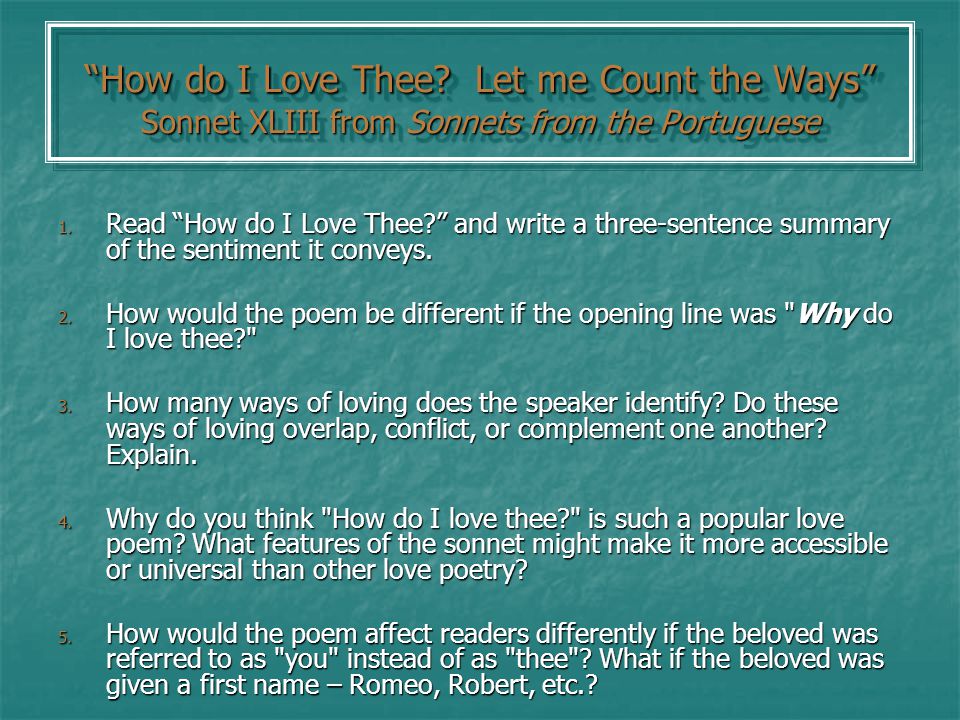
Elizabeth Barrett Browning Ppt Video Online Download
How do i love thee (sonnet 43)
How do i love thee (sonnet 43)-Feb 22, · She says that she loves the subject freely and purely with the intensity of the suffering Furthermore, she "shall love him better after death " The dominant figure of speech in the poem is anaphora, the use of "I love thee" in eight linesThe dominant figure of speech in the poem is anaphora—the use of I love thee in eight lines and I shall but love thee in the final line This repetition builds rhythm while reinforcing the theme Browning also uses alliteration, as the following examples illustrate thee, the (Lines 1, 2, 5, 9
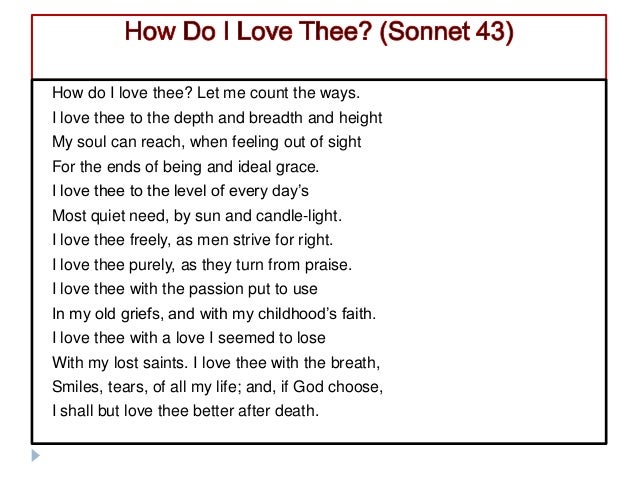



Sonnet 43 How Do I Love Thee By Elizabeth Barrette Browning
It is probably the famous sonnet of all, we should read it at least once SONNET 18 Shall I compare thee to a summer's day? If one were to ever receive a love poem, Shakespeare's Sonnet 43 would be and excellent poem to receive The sonnet is addressed to the beloved of the speaker The speaker talks about how the best thing he sees is upon the closing of his eyes, when he then pictures the beloved The speaker talks about how the rest ofJan 24, 21 · How do I love thee Sonnet 43 figure of speech?
Feb 01, 15 · Task Give examples of figures of speech from the poem Provide the definition of each term and explain their use in the text For this activity, why don't we use Sonnet 18 by Shakespeare?Sep 15, · When verbalised, the rhythm and concept are effectively synchronised, developing a sense that Browning articulates the force and intensity of her passion on a more truthful intellect In lines 910 of "Sonnet 43," the speaker asserts that she loves withReread the figurative language in line 31 of "Remembrance"Let me count the ways) Poem Text
Let me count the ways I love thee to the depth and breadth and height My soul can reach, when feeling out of sight For the ends of being and ideal grace I love thee to the level of every day's Most quiet need, by sun and candlelight I love thee freely, as men strive for rightLet me count the ways I love thee to the depth and breadth and height My soul can reach, when feeling out of sight For the ends of being and ideal grace I love thee to the level of every day's Most quiet need, by sun and candlelight I love thee freely, as men strive for right I love thee purely, as they turn from praiseWhat does Sonnets from the Portuguese mean?




3 04 Toastt Graphic Organizer 3 04 Toastt Graphic Organizer Poem How Do I Love Thee Let Me Count The Ways I Love Thee To The Depth And Breadth Course Hero




Sonnet 43 How Do I Love Thee By Elizabeth Barrette Browning
Learn Sonnet 43 (Elizabeth Barrett Browning) with free interactive flashcards Choose from 241 different sets of Sonnet 43 (Elizabeth Barrett Browning) flashcards on QuizletSonnet 43 was written in secret in Patriarchal style by Elizabeth Barrett Browning It was written in first person with dominant figure of speech anaphora Expressing the intense love she feels for her husbandtobe, Whereas Sonnet 116 is about love in the most ideal formSummary of Sonnet 43 • Begins with the narrator trying to measure the size of her love But by trying, she reveals that it is impossible • She then compares her love to her vast love of God • She then says her love is present in normal day to day activities
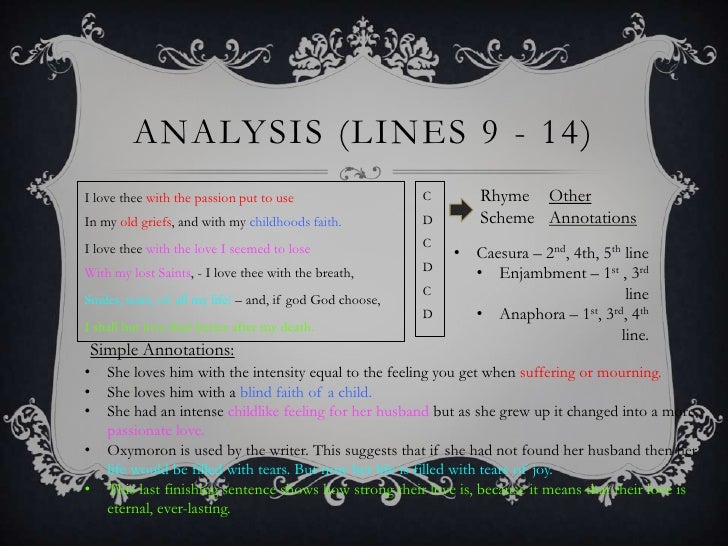



Sonnet 43 1
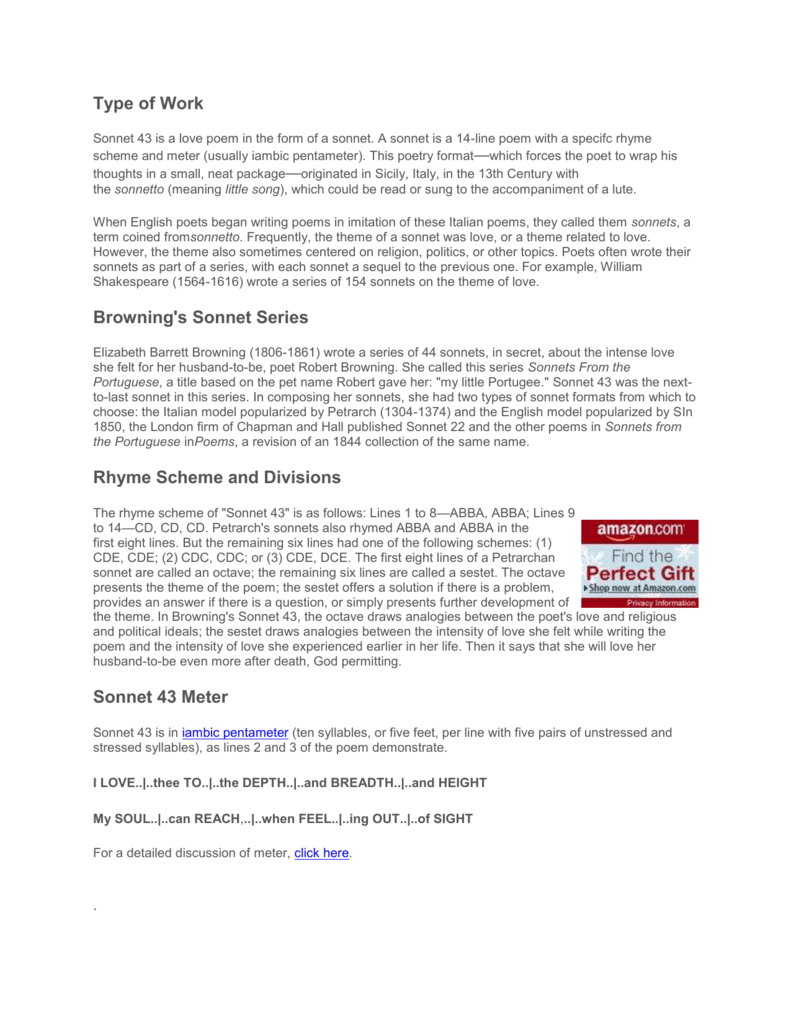



Sonnet 43 Browning Doral Academy Preparatory
Apr 15, 14 · How do I love thee?I love thee to the depth & breadth & height My soul can reach, when feeling out of sight For the ends of Being and Ideal Grace I love thee to the level of everyday's Most quiet need, by sun and candlelight – I love thee freely, as men strive for Right, – I love theeSonnet 43 "How do I love thee?
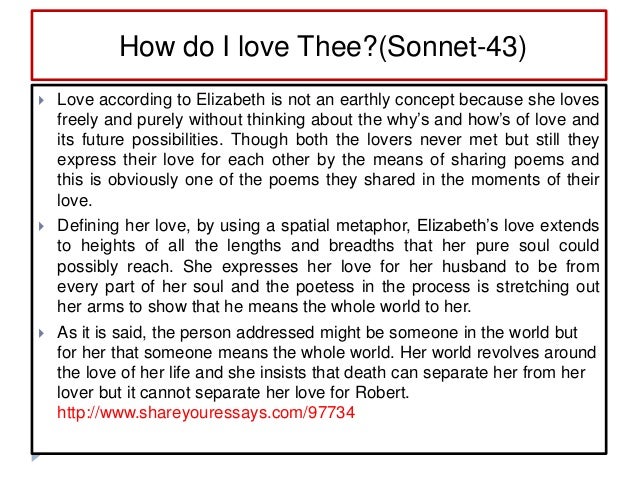



Sonnet 43 How Do I Love Thee By Elizabeth Barrette Browning
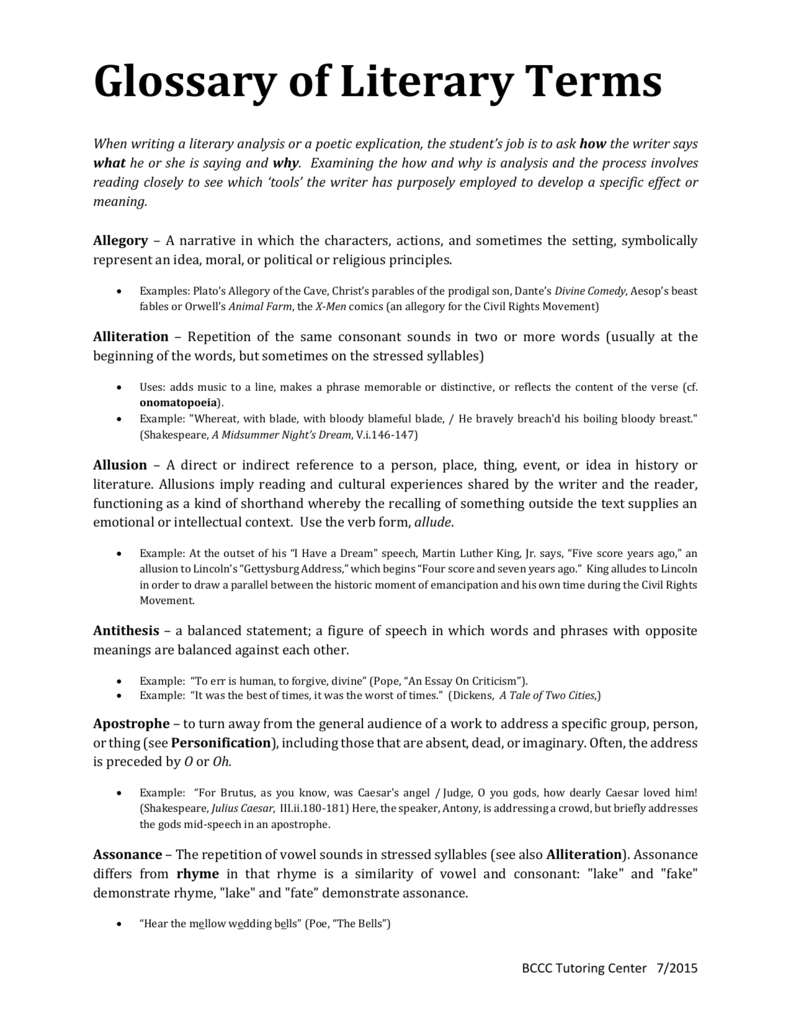



Doc
May 07, · Study Guide for Sonnet 43 (How do I love thee?Mar 24, 11 · I love thee purely, as they turn from Praise I love thee with the passion put to use In my old griefs, and with my childhood's faith I love thee with a love I seemed to lose With my lost saints – I love thee with the breath, Smiles, tears, of all my life!This sonnet, in iambic pentameter, portrays the love that Browning felt for her husband and how that love will never be destroyed by any power Answering the simple question, " how do I love thee ?" sets the basis of the poem
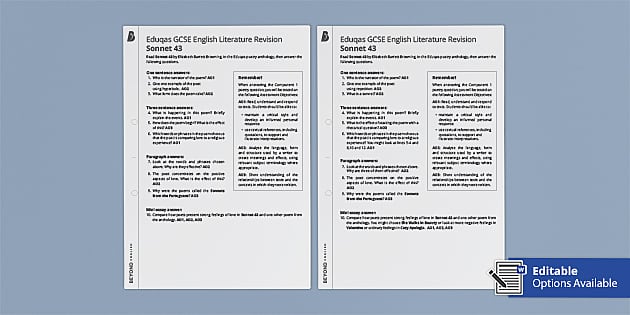



How Do I Love Thee Sonnet 43 Elizabeth Barrett Browning
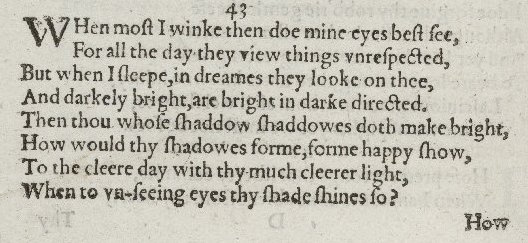



Sonnet 43 Wikipedia
Mar 26, 21 · The main literary device used in Sonnet 18 is metaphor It also uses rhyme, meter, comparison, hyperbole, litotes, and repetitionThe main purpose of Shakespeare's Sonnet 18 is embodied in the end couplet So long as men can breathe or eyes can see, So long lives this and this gives life to theeElizabeth Barrett Browning How do I love thee Video edited by Andreea Petcu(oceanflower1)http//wwyoutubecom/Newoceanflower08Dolls & Action Figures Stuffed Animals Elizabeth Barrett Browning, How Do I Love Thee, Sonnet 43, Poetry Art Quote, Bedroom Wall Decor, Love Print, Book Page Art, Literary Print DebbraObertanecArt From shop DebbraObertanecArt 5 out
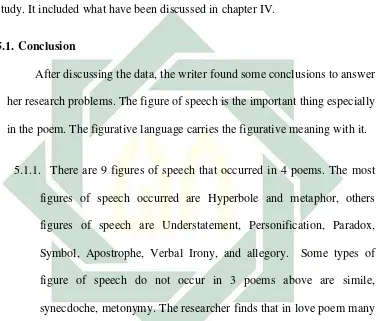



Figure Of Speech In The Elizabeth Barrett Browning S Poems




Three Elements Of A Poem Term Paper Example Topics And Well Written Essays 500 Words
Mar 24, 21 · Sonnet 43 Analysis Summary The author starts the poem by asking the question, "How do I love thee?" and responding with, "Let me count the ways" One might assume that the speaker is either musing out loud – as one might do when writing a letter – or responding to a lover who might have presented such a questionLet me count the ways She then uses the last thirteen lines of the poem to show just how much she loves her husband Lines 24 of Sonnet 43 provide the first way in which the speaker loves her husband Barrett Browning writes, I love thee to the depth and breadth and height My soul can reach, when feeling out of sightApr 25, 13 · Sonnet 43 By Elizabeth Barrett Browning Sara Riedesel and Masuzgo Mhango I love thee to the level of every day's Most quiet need, by sun and candlelight I love thee freely, as men strive for right I love thee purely, as they turn from praise




Sonnet 43 Analysis How Do I Love Thee By Elizabeth Barrett Browning Learn Cram




How Do I Love Thee Let Me Count The Ways Sonnets From The Portuguese 43 Poem Summary And Analysis Litcharts
What is the rhyme scheme of Sonnet 43 quizlet?(Sonnet 43) By Elizabeth Barrett Browning How do I love thee?Ans The various figures of speech used in Sonnet 43 are described as follows Anaphora The main figure of speech in the poem is anaphora— the use of I love thee in eight lines and I shall but love thee in the final line This repetition produces rhythm thus reinforcing the theme




How Do I Love Thee Sonnet 43 Teaching Resources




How Do I Love Thee By Elizabeth Barrett Browning Sonnet 43 Analysis Youtube
Feb 11, · "I love thee with a love I seemed to lose/With my lost saints" – The speaker exalts her lover by comparing him to saints or people capable of being as pure and perfect as saints "I love thee with the breath,/Smiles, tears, of all my life" – The speaker describes her love as a deeply physical experience, as if this affection is contained within every breath and movementFastest (2x) part of speech definition Powered by Word smyth How do I love thee?" In the sonnet, Browning proceeds to find, describe and list the ways in which you can love someone She says that she loves the subject to the spiritual level




Read A Study Guide For Elizabeth Barrett Browning S How Do I Love Thee Sonnet 43 Online By Gale And Cengage Books




How Do I Love Thee On Tumblr
Let me count the ways) Sonnet 43 (How do I love thee?May 23, 12 · Sonnet 43, A Touching Love Poem Feb 09, 16 · Only in heaven could it be greater That's a powerful statement of love I have family and friends whom I love with all of my heart, and I hope one day I will find love in a romantic way If you have found that kind of love, I admire you and am jealous If you haven't, then I hope you too will find it someday




Read How Do I Love Thee Let Me Count The Ways Essay Sample For Free At Supremeessays Com




How Do I Love Thee
About Press Copyright Contact us Creators Advertise Developers Terms Privacy Policy & Safety How works Test new features Press Copyright Contact us CreatorsApr 17, · The theme of Sonnet 43 is intense love that will become stronger after death Browning begins the sonnet with a question – "How do I love thee?The sequence is comprised of 44 sonnets, with "How do I love thee?" appearing in the striking position of number 43, or secondtolast, making it an important part of the climax Most critics agree that Barrett Browning wrote the sonnets, not as an abstract literary exercise, but as a personal declaration of love to her husband, Robert Browning (who was also an important




Commonlit Sonnet 43 Free Reading Passages And Literacy Resources
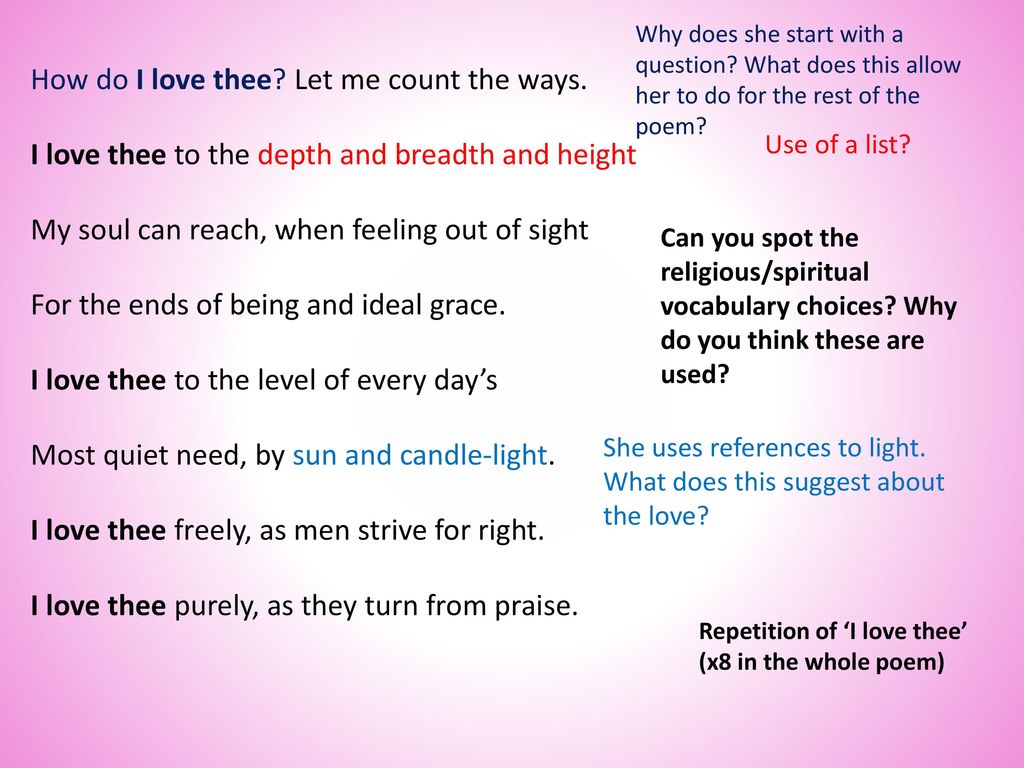



Sonnet 43 Elizabeth Barrett Browning Ppt Download
How Do I Love Thee?Feb 05, 21 · Let me count the ways I love thee to the depth and breadth and height My soul can reach, when feeling out of sight For the ends of being and ideal grace I love thee to the level of every day's Most quiet need, by sun and candlelight I love thee freely, as men strive for right I love thee purely, as they turn from praiseHow do I love thee Sonnet 43 figure of speech?
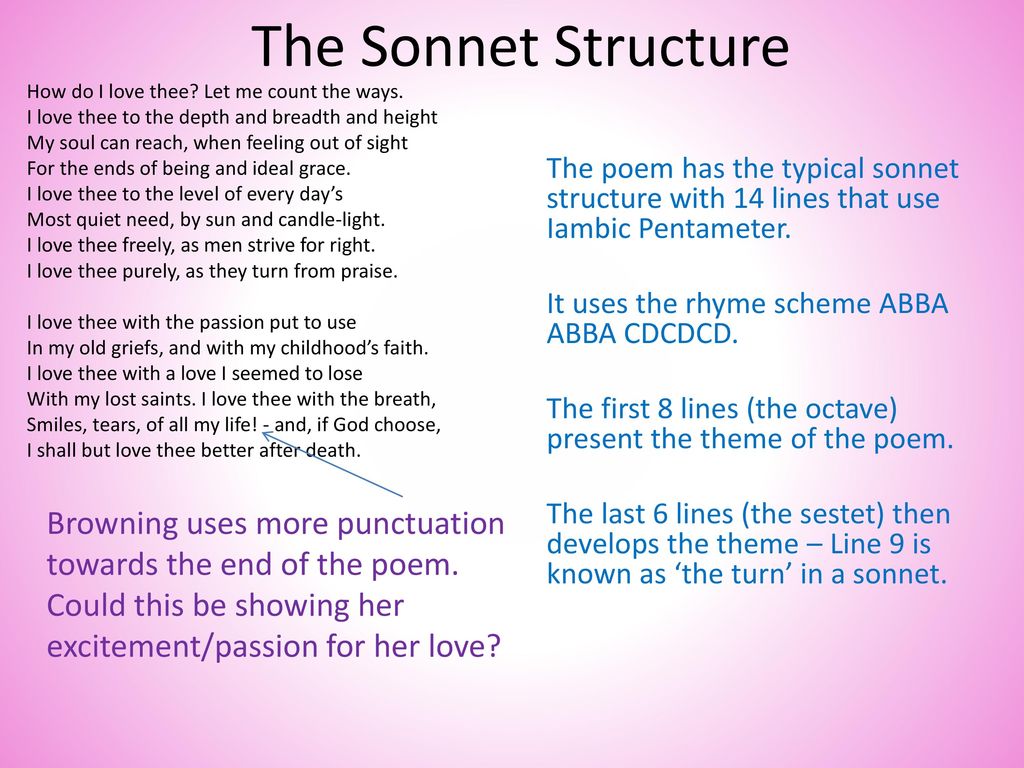



Sonnet 43 Elizabeth Barrett Browning Ppt Download




Sonnet 43 How Do I Love Thee Elizabeth Barrett Browning Teaching Resources
Jan 01, 15 · Studying The Sonnet Of Elizabeth Barrett Browning English Literature Essay Elizabeth Barrett Browning's sonnet "How do I love thee?"is a powerful expression of love, reflecting upon her moving experience during her courtship with Robert Browning (Sonnets from the Portuguese 43, The Norton Anthology of Poetry, pg 947)The title of this post comes from one of the most famous British sonnets – Elizabeth Barrett Browning's () Sonnet 43 (Sonnets from the Portuguese)This sonnet ends with the words I shall but love thee better after deathI have chosen this as a motto for the poem written by Elizabeth Barrett's husband, a Victorian poet, Robert Browning ()Feb 13, 18 · Let me count the ways I love thee to the depth and breadth and height My soul can reach, when feeling out of sight For the ends of being and ideal grace I love thee to the level of every day's Most quiet need, by sun and candlelight I love thee freely, as men strive for right I love thee purely, as they turn from praise




Sonnet 43 How Do I Love Thee Let Me Count Poem Analysis




Sonnet 43 Analysis How Do I Love Thee By Elizabeth Barrett Browning Learn Cram
Apr , 21 · The most prominent figure of speech used in "Sonnet 18" is the extended metaphor comparing Shakespeare's lover to a summer's day throughout the whole sonnet Comparing the lover's beauty to an eternal summer, "But thy eternal summer shall not fade" (line nine) is a metaphor inside the sonnetlong extended metaphorLet me count the ways I love thee to the depth and breadth and height My soul can reach, when feeling out of sight For the ends of Being and ideal Grace I love thee to the level of everyday's Most quiet need, by sun and candlelight I love thee freely, asHere's one of mine What figures of speech do you find?




Sonnet 43 By Elizabeth Barrett Browning Nick Andhika And ron Ppt Download




If Thou Must Love Me Let It Be For Nought Sonnets From The Portuguese 14 Poem Summary And Analysis Litcharts
Mar 21, · Q What are the different figures of speech used in the poem 'Ho Do I Love Thee'?What varies is the way the love works and how intense it actually is The thing itself – the word "love" – always remains consistent, reminding us that the speaker's love for her beloved is a constant and unchanging thing It varies, of course, but it doesn't actually change The phrase "I love thee," repeated until it almost becomesFeb 13, 12 · In Elizabeth Barrett Browning's "Sonnet 43," identified by literary critics as addressing the poet's husband, Robert Browning, the speaker begins the poem by expressing metaphorically how she seeks to measure or quantify the love she possesses I love thee to the depth and breadth and height My soul can reach The speaker also uses similes to describe her




Elizabeth Barrett Browning Ppt Video Online Download
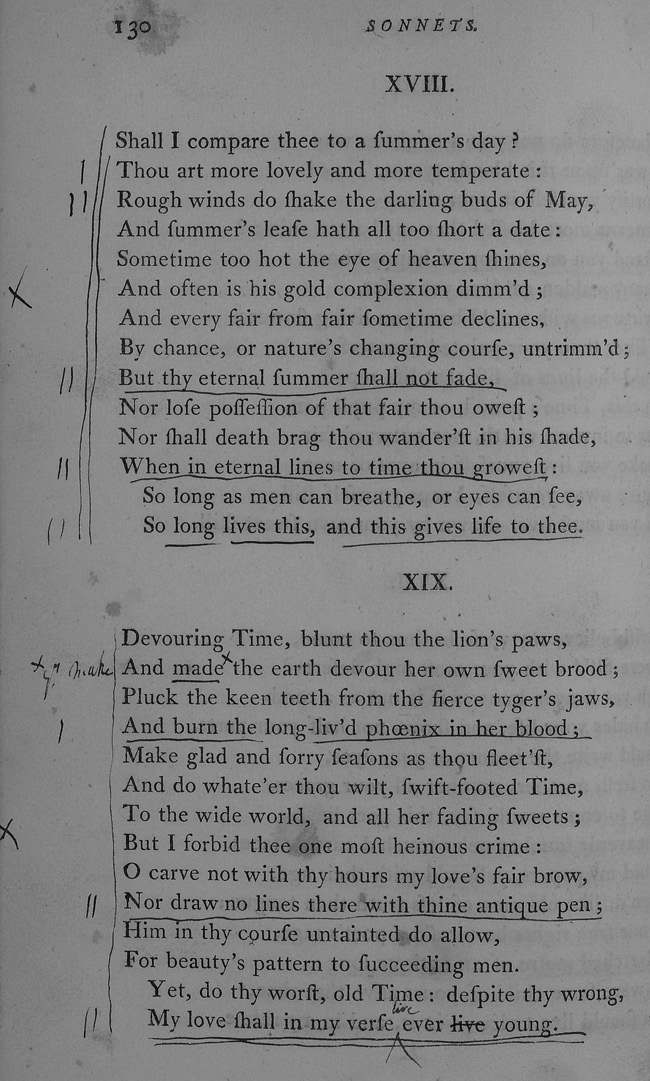



As With Your Shadow I With These Did Play 1817 1900 Chapter 4 The Afterlife Of Shakespeare S Sonnets
Citations about Analyzing "How Do I Love Thee?" by Elizabeth Barrett Browning Essay The fulfillment of the speech act "consists in its recognition" (6) as is clearly illustrated in this caseYet the poem still successfully has the impact of being a passionate declaration of love, convincing us that this love is not a passing fancy but real and everlastingDolls & Action Figures Stuffed Animals Games & Puzzles How Do I Love Thee, Sonnet 43, Poetry Art Quote, Bedroom Wall Decor, Love Print, Book Page Art, Literary Print DebbraObertanecArt 5 out of 5 stars (1,157) $ 1600 FREE shippingMar 24, 11 · 'Sonnet 43' is a romantic poem, written by Elizabeth Barrett Browning In the poem she is trying to describe the abstract feeling of love by measuring how much her love means to her She also expresses all the different ways of loving someone and she tells us about her thoughts around her beloved The tone of the poem is deep, in a loving way




Pin On Poetry




Sonnet 43 By Elizabeth Barrett Browning Nick Andhika And ron Ppt Download
I love thee to the depth and breadth and height My soul can reach, when feeling out of sight For the ends of Being and ideal Grace I love thee to the level of everyday's Most quiet need, by sun and candlelight I love thee freely, as men strive for Right;– and, if God choose, I shall but love thee better after deathLet me count the ways I love thee to the depth and breadth and height My




How Do I Love Thee Sonnet 43 National Poetry Day




Woman S Passions In Elizabeth Barrett Browning S Poems Entitled The Lady S Yes And How Do I Love Thee
Jul 30, 16 · How do I love thee?Let me count the ways) study guide contains a biography of Elizabeth Browning, literature essays, quiz questions, major themes, characters, and a full summary and analysis About Sonnet 43 (How do I love thee?Elizabeth Barrett Browning uses many different aspects of figurative language in "Sonnet 43," outside of the more typically used ones First, she uses apostrophe Apostrophe is where a poet




Sonnet 43 By Elizabeth Barret Browning Ppt Download




How Do I Love Thee By Elizabeth Barrett Browning Sonnet 43 Analysis Youtube
The Kiss Lids glide closed Like leaves of autumn fall Lips so shyly part Proprietry deposed Cracked, then crumbled wall Never ending, without a start So slowly touch It seems theyThe poem "How do I love thee" is a sonnet, so it traditionally has rhyme, consists of fourteen lines and is written in iambic pentameter There are several rhyme schemes for sonnets and the rhyme scheme of this one is ABBA, ABBA, CDC, DCDJun 11, 17 · This sonnet has much figurative languages, they are anaphora, assonance, personification, similes, hyperbole and imagery Anaphora The words that show the anaphora in this poem are "I love thee", the repetition of the words "I love thee" comes at
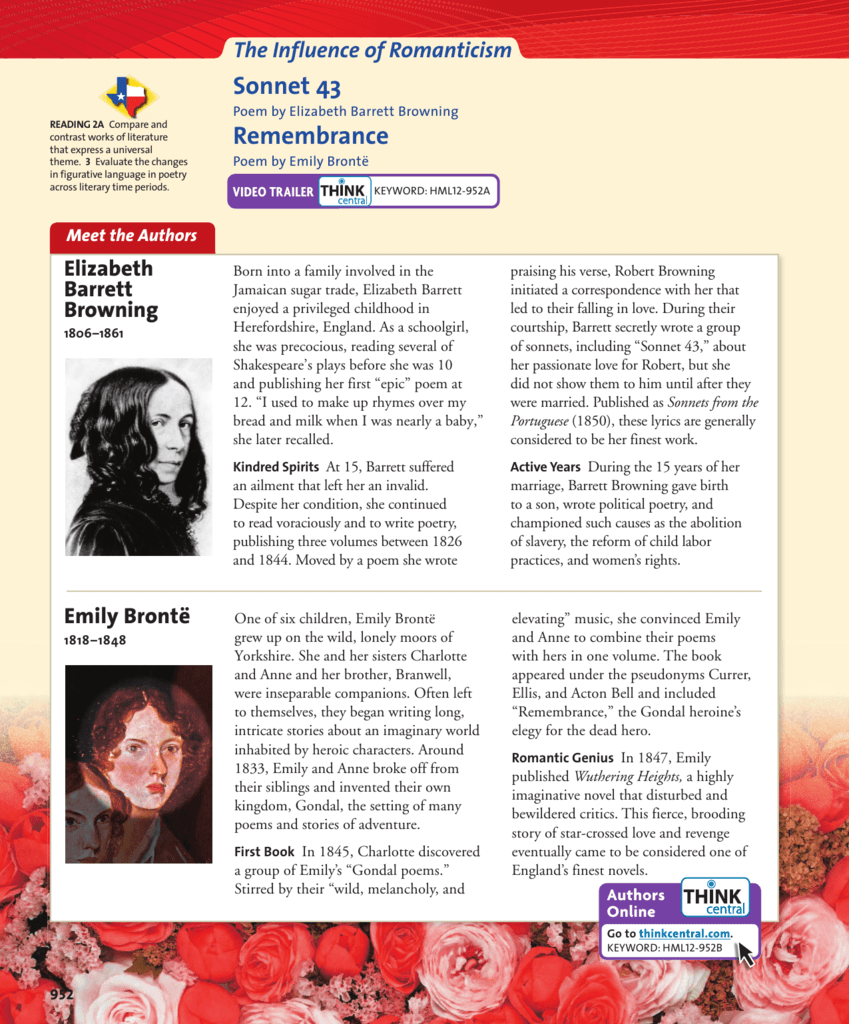



Sonnet 43 Remembrance




How Do I Love Thee Let Me Count The Ways Sonnets From The Portuguese 43 Poem Summary And Analysis Litcharts
Oct 18, 19 · A figure of speech is a phrase which describes something in a figurative, or nonliteral, way Metaphors and similes are the most common types of figures of speech In "How Do I Love Thee?" byFeb 14, 18 · OnValentine's Day, February 14, 18, the CBC New Brunswick radio program Shift broadcast Robert Lapp's reading of Elizabeth Barrett Browning's Sonnet 43, How Do I Love Thee To listen to it, click on the media playerLet me count the ways I love thee to the depth and breadth and height My soul can reach, when feeling out of sight For the ends of being and ideal grace I love thee to the level of every day's Most quiet need, by sun and candlelight I love thee freely, as men strive for right I love thee purely, as they turn
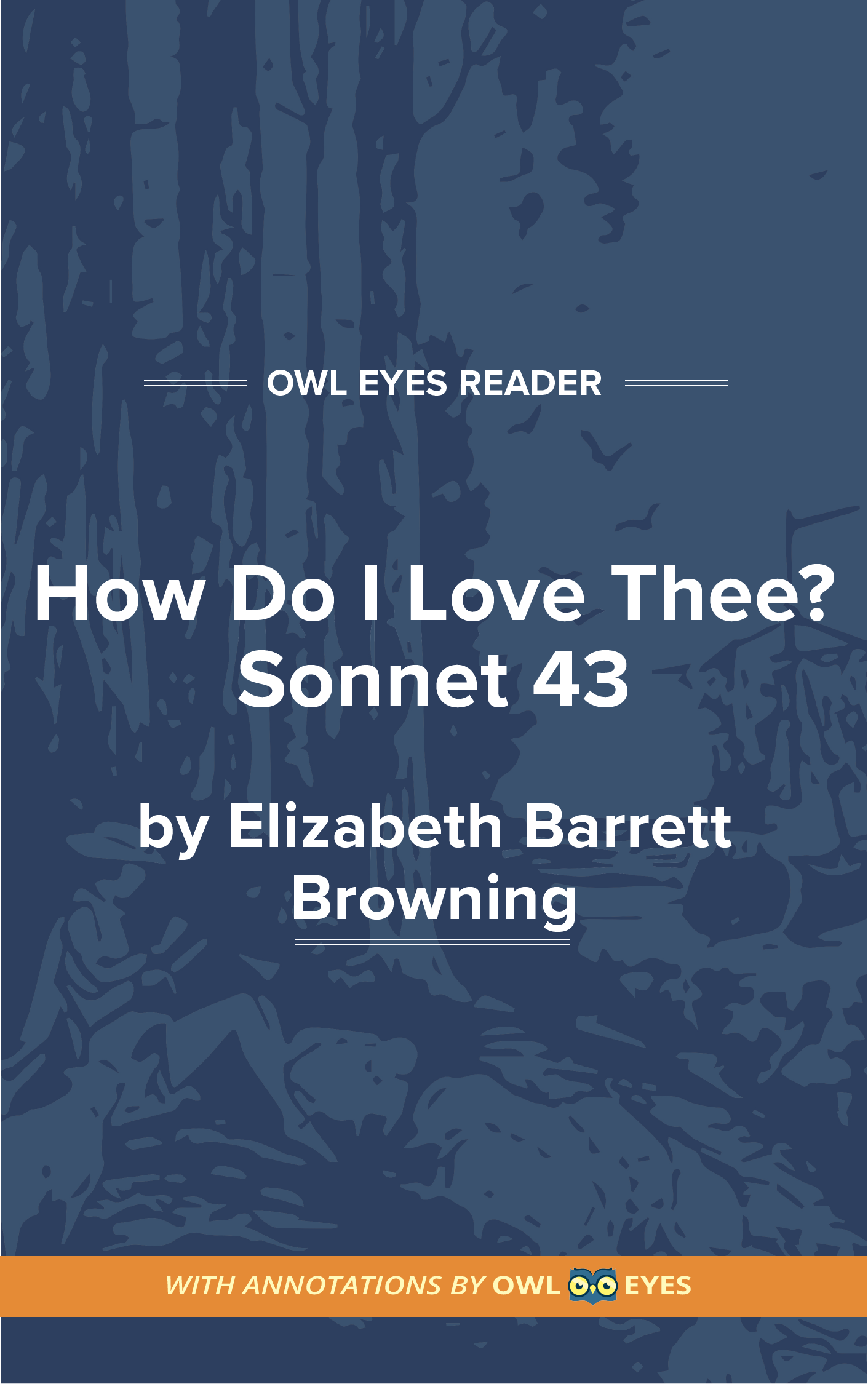



Literary Devices In How Do I Love Thee Owl Eyes




Teacher Guide For Fast R Passage Fast R Formative Assessments Of Student Thinking In Reading Pdf Free Download
Feb 04, 17 · Sonnet 43 How do I love thee?
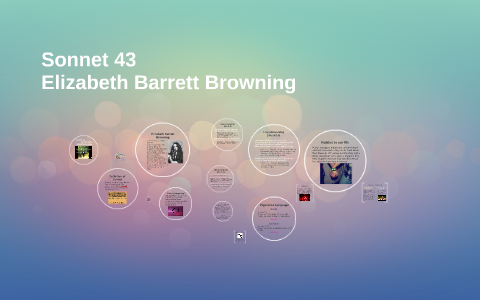



Sonnet 43 By Jennifer Guo




Sonnet 18 Shall I Compare Thee To A Summer S Day Figurative Language Jibhai Global




Woman S Passions In Elizabeth Barrett Browning S Poems Entitled The Lady S Yes And How Do I Love Thee




Ppt Poem Song Project Powerpoint Presentation Free Download Id




Sonnet 43 How Do I Love Thee Let Me Count The Ways Literary Elements Gradesaver
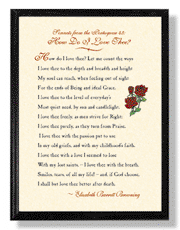



Sonnet 43 By Elizabeth Barrett Browning Quiz Proprofs Quiz
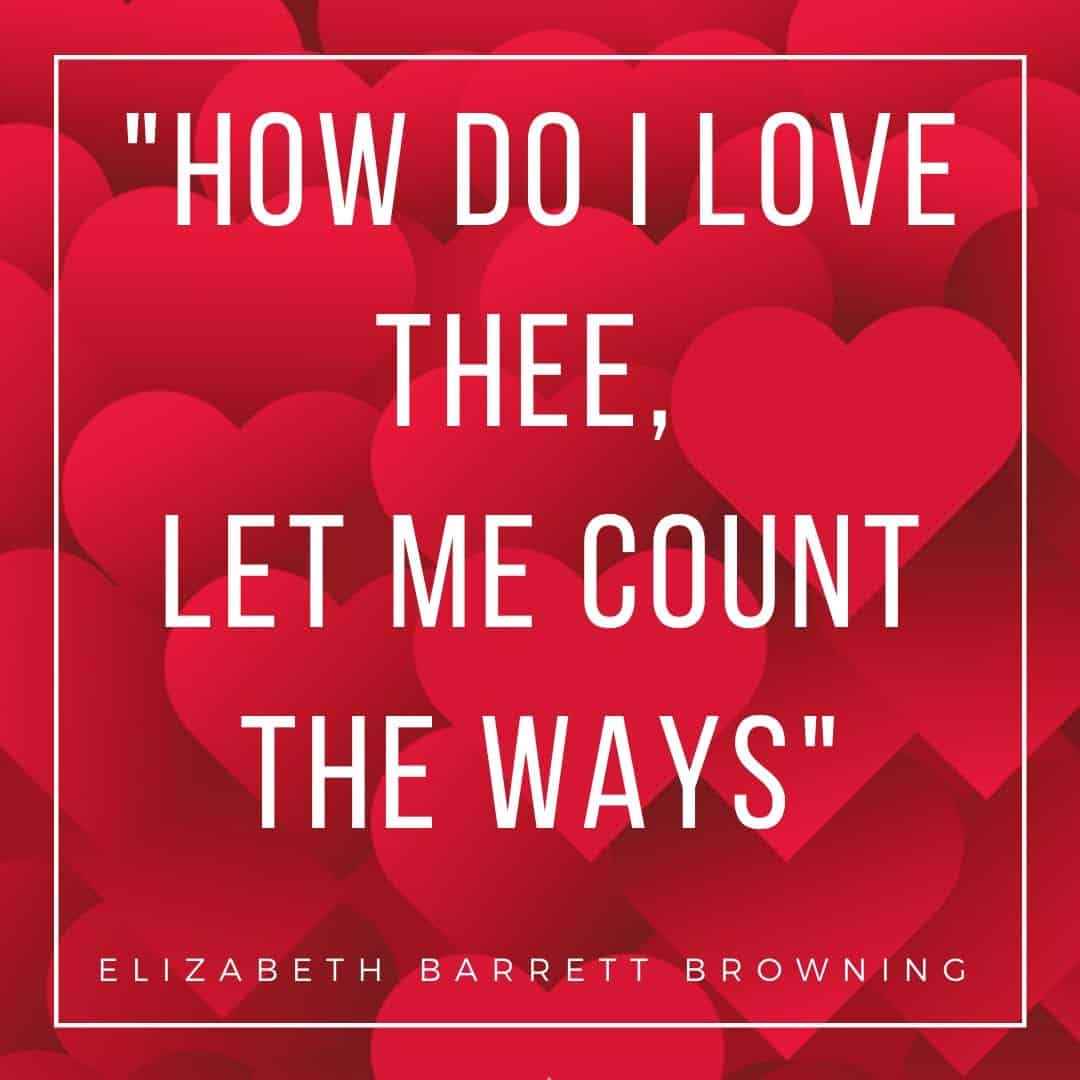



How Do I Love Thee Let Me Count The Ways Sonnet Analysis




Elizabeth Barrett Browning How Do I Love Thee How Do I Love Thee Let Me Count The Ways I Love Thee To The Depth And Breadth And Height My Soul




How Do I Love Thee Sonnet 43 Elizabeth Barrett Browning 1806 1861 How Do I Love Thee Let Me Count The Ways I Love Thee To The Depth And Breadth And
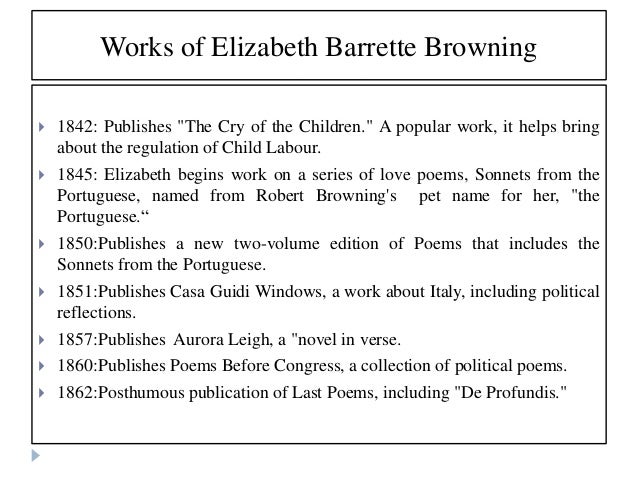



Sonnet 43 How Do I Love Thee By Elizabeth Barrette Browning




English Poetry Ii Ii Elizabeth Barrett Browning 6




How Do I Love Thee Worksheets Teaching Resources Tpt
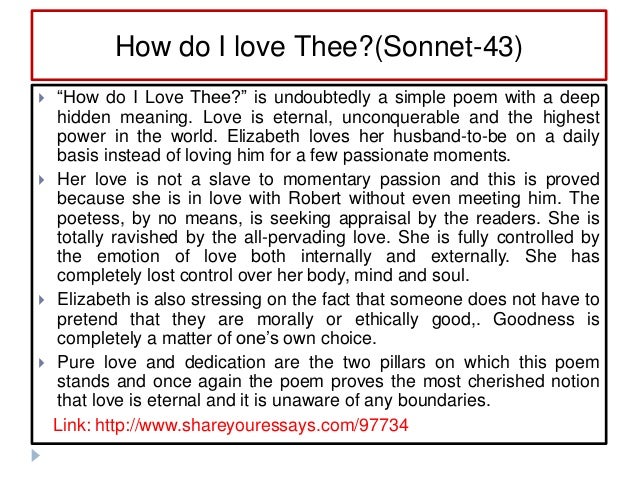



Sonnet 43 How Do I Love Thee By Elizabeth Barrette Browning
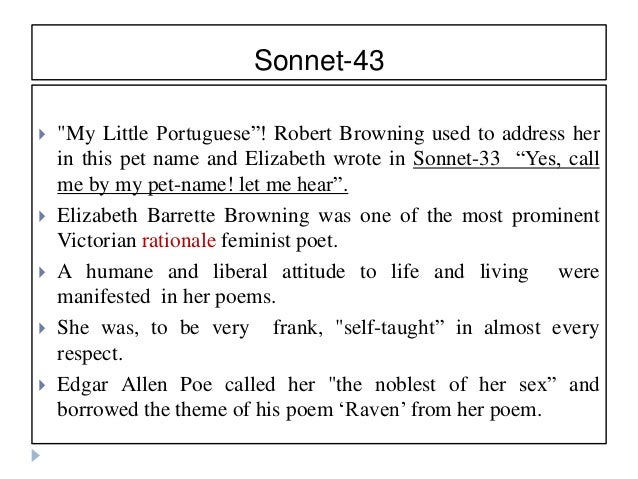



Sonnet 43 How Do I Love Thee By Elizabeth Barrette Browning




The Analysis Of Poem How Do I Love Thee Let Me Count The Ways A Cup Of Hot Chocolate




Teacher Guide For Fast R Passage Fast R Formative Assessments Of Student Thinking In Reading Pdf Free Download



Analysis Of How Do I Love Thee By Elizabeth Barret Browning Gcse English Marked By Teachers Com




Introduction To Poetry Posts Facebook
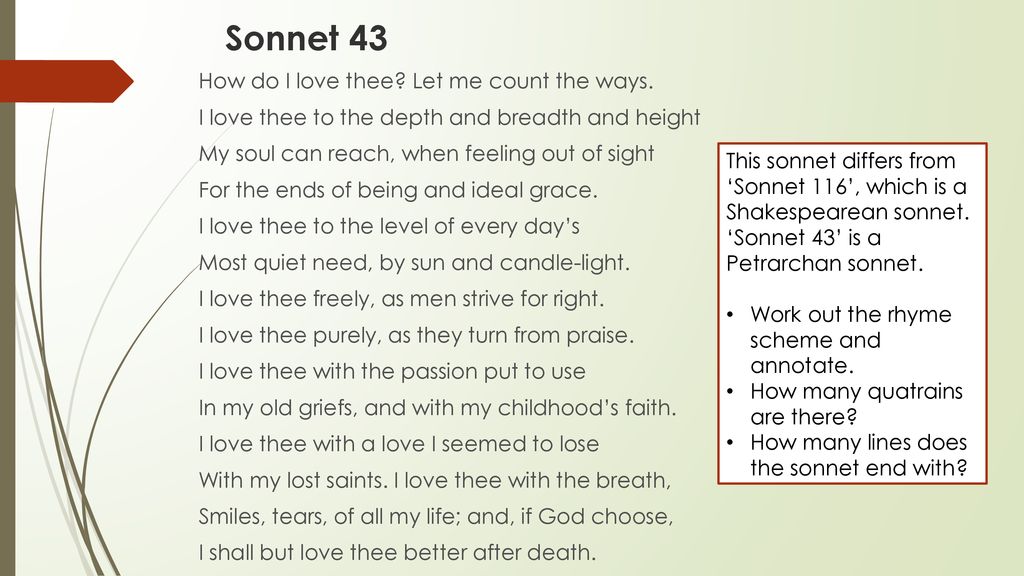



Sonnet 43 Sonnet 116 Elizabeth Barret Browning William Shakespeare Ppt Download




Teacher Guide For Fast R Passage Fast R Formative Assessments Of Student Thinking In Reading Pdf Free Download
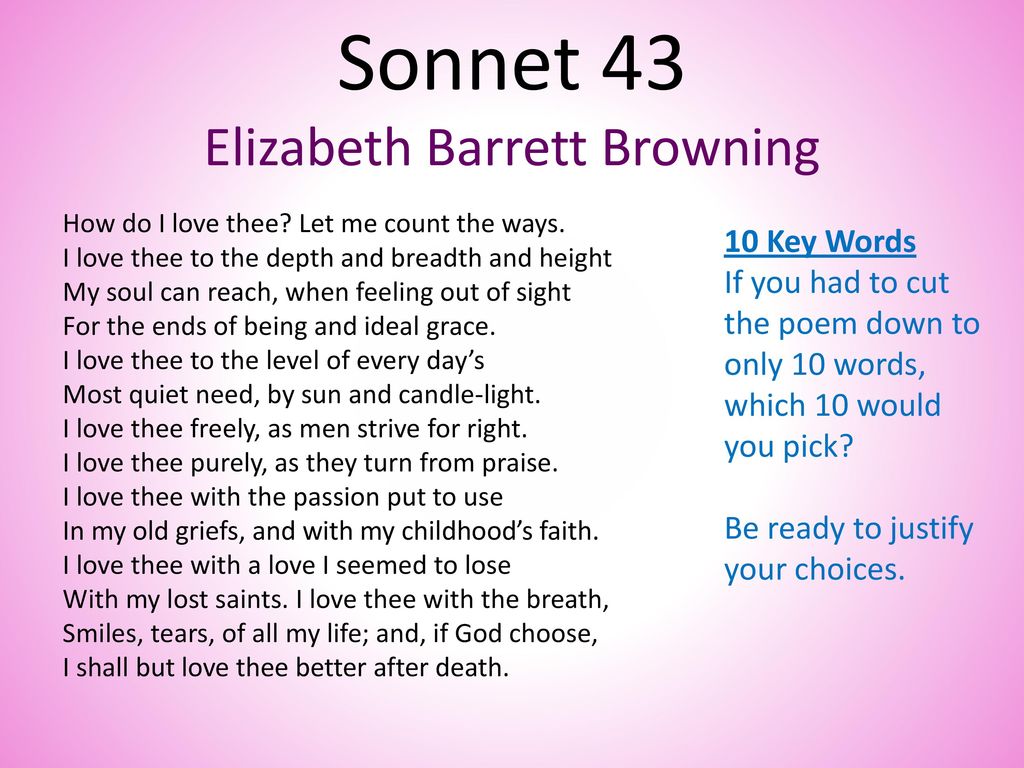



Sonnet 43 Elizabeth Barrett Browning Ppt Download
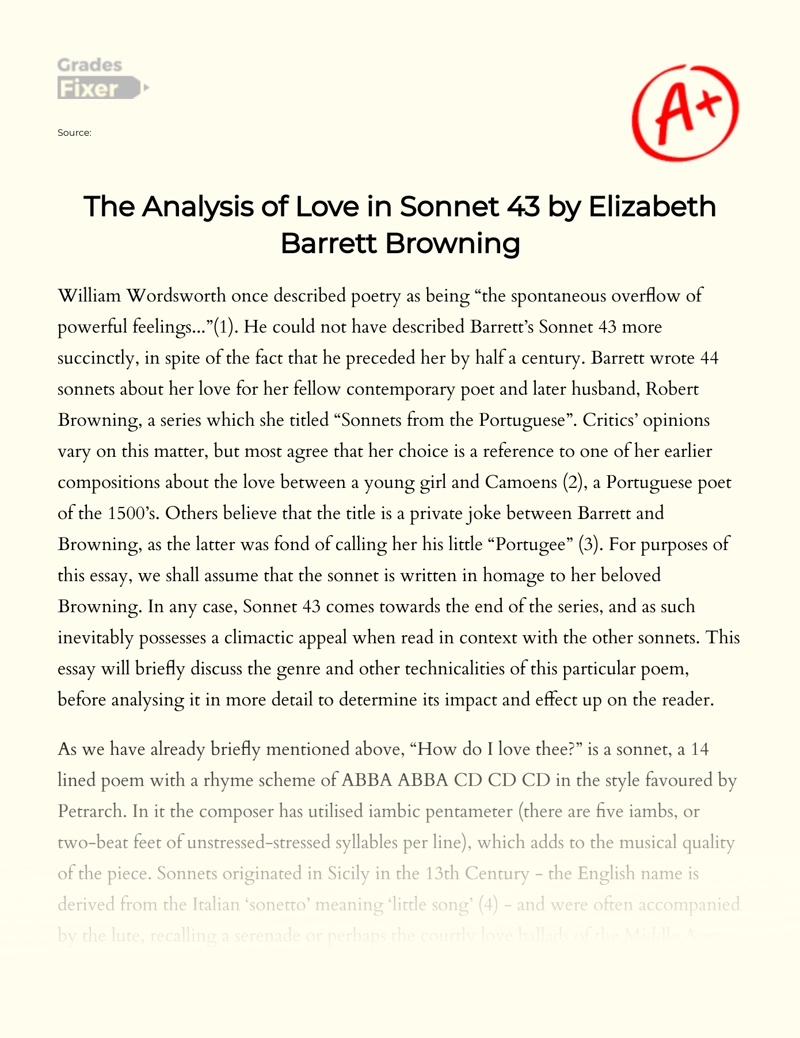



The Analysis Of Love In Sonnet 43 By Elizabeth Barrett Browning Essay Example 1507 Words Gradesfixer
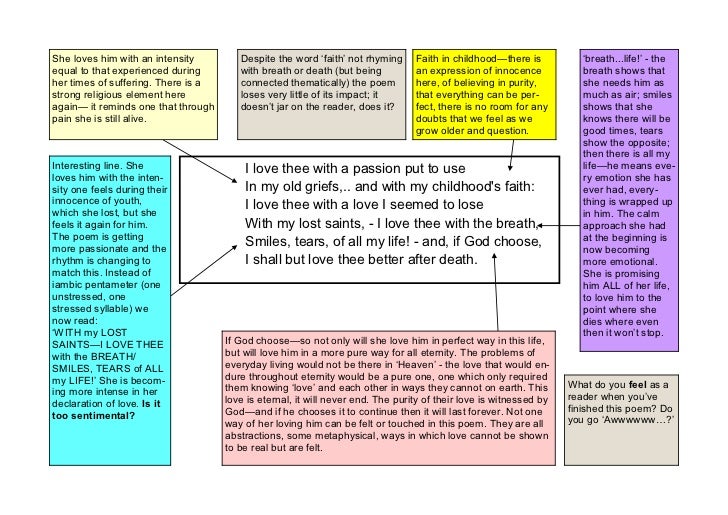



Sonnet 43
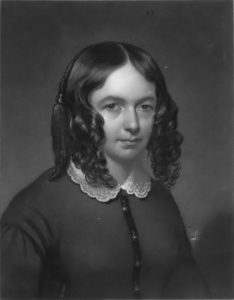



How Do I Love Thee By Elizabeth Barrett Browning Sonnet Composition And Literature
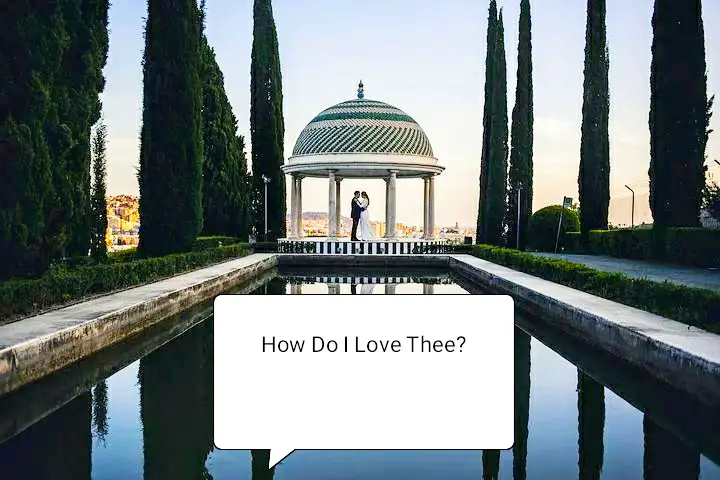



Sonnet Xliii By Elizabeth Barrett Browning Questions And Answers Smart English Notes
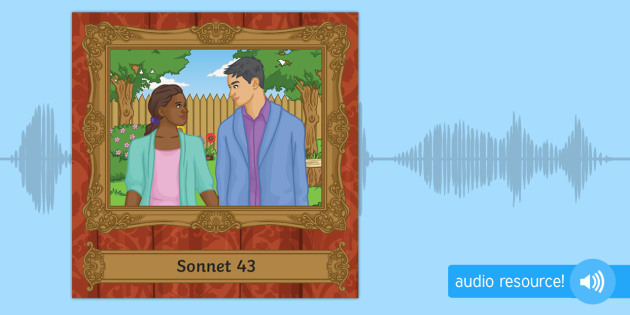



Gcse Audio Poem Sonnet 43 Audio Book Teacher Made




Sonnet 43 How Do I Love Thee By Elizabeth Barrette Browning




Honours I How Do I Love Thee




Analysis Of Poem How Do I Love Thee By Elizabeth Barrett Browning Owlcation



How Do I Love Thee Sonnet 43 Clea Mclemore




Sonnet 43 By Elizabeth Barrett Browning Nick Andhika And ron Ppt Download
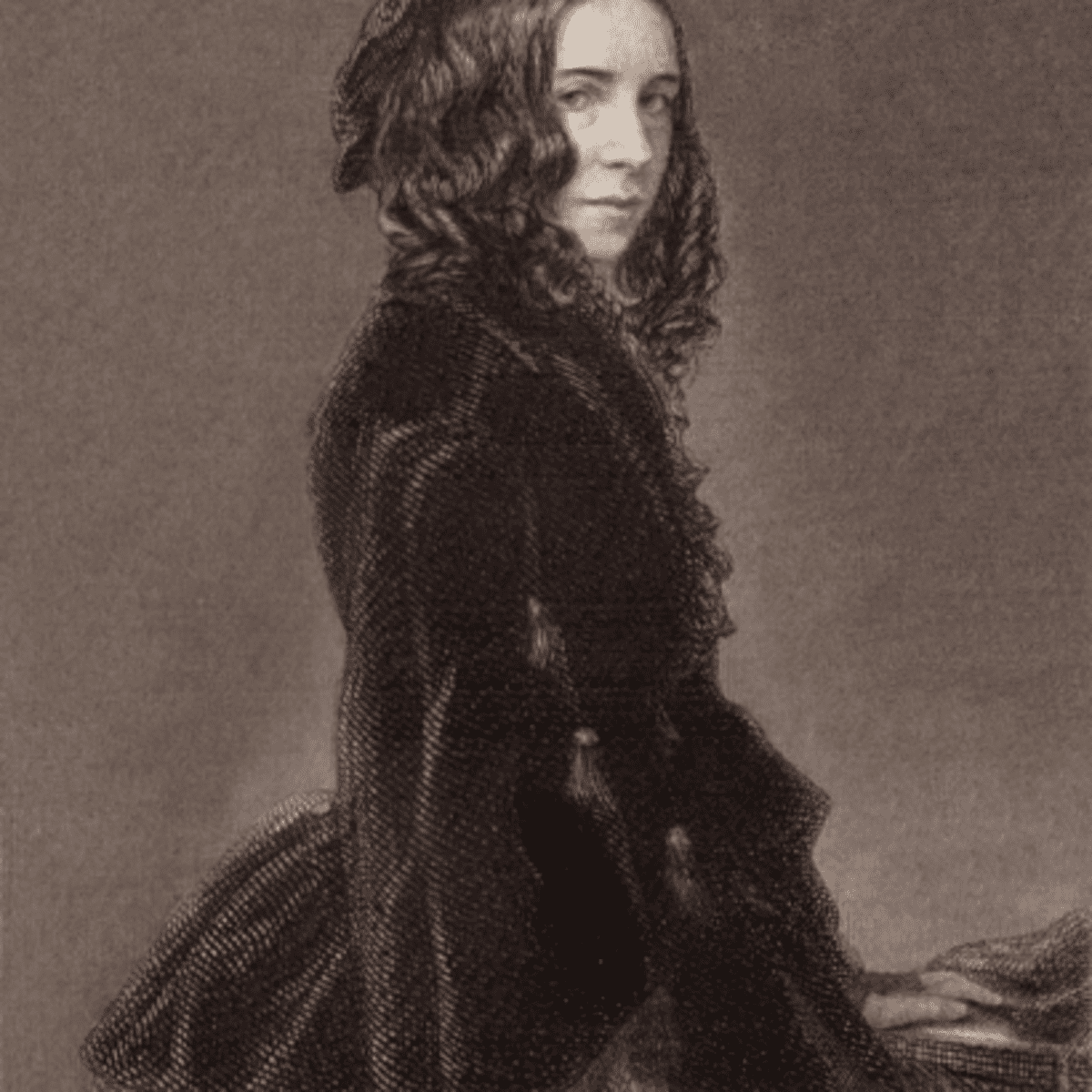



Analysis Of Poem How Do I Love Thee By Elizabeth Barrett Browning Owlcation
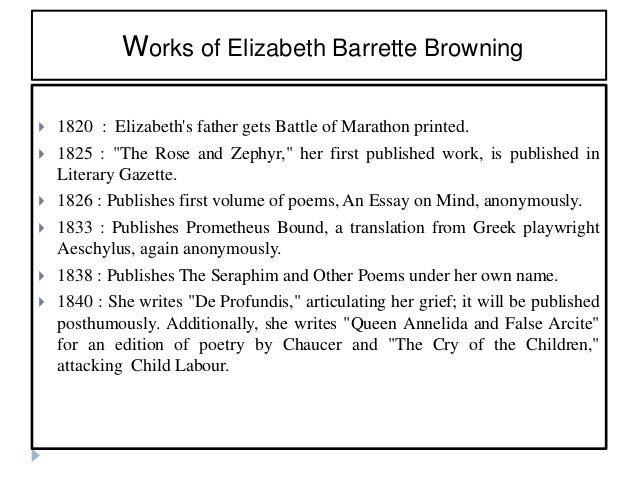



Sonnet 43 How Do I Love Thee By Elizabeth Barrette Browning




Doc Elizabeth Barrett Browning Sonnet 1 Jonathan Tam Academia Edu



Analysis Of Sonnet 43 How Do I Love Thee By Elizabeth Barrett Browning Gcse English Marked By Teachers Com
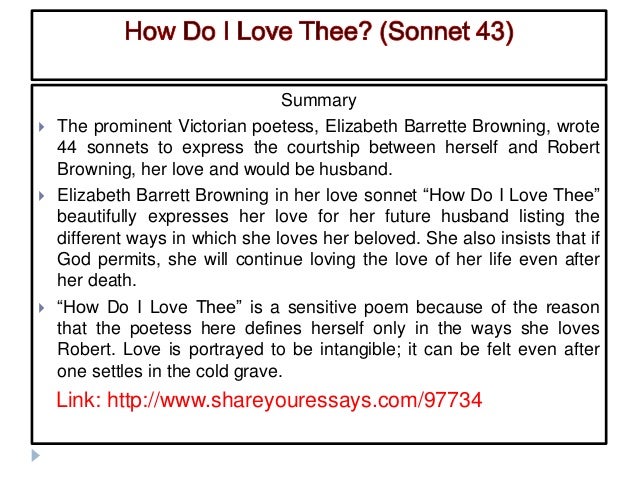



Sonnet 43 How Do I Love Thee By Elizabeth Barrette Browning




Sonnet 43 Sonnet 43 By Elizabeth Barrett Browning An Absolutely Informal And Terrible Synopsis Of The Poem By Millicent Keuper How Do I Love Thee Let Course Hero




Elizabeth Barrett Browning Sonnet 43 Robert Browning My Last Duchess Ppt Download




Sonnet 43 Analysis




The Analysis Of Poem How Do I Love Thee Let Me Count The Ways A Cup Of Hot Chocolate




Sonnet 26 Wikipedia




How Do I Love Thee Let Me Count Ways Sonnet 43 Elizabeth Browning Lyrics Words Text Sing Along Song Youtube




Sonnet 43 Sonnet 43 How Do I Love Thee Let Me Count The Ways Summary
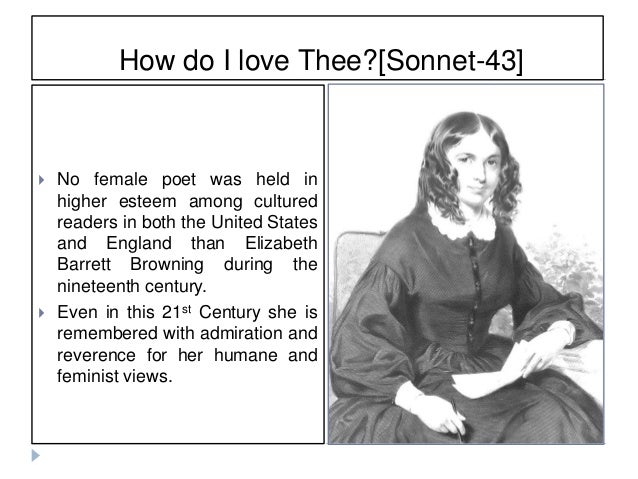



Sonnet 43 How Do I Love Thee By Elizabeth Barrette Browning




Sonnet 43 How Do I Love Thee By Elizabeth Barrette Browning
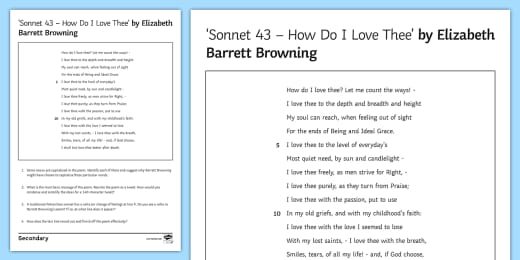



84 Top Sonnet Teaching Resources




Elizabeth Barrett Browning Sonnet 43 Robert Browning My Last Duchess Ppt Download



Analysis Of Sonnet 43 How Do I Love Thee By Elizabeth Barrett Browning Gcse English Marked By Teachers Com
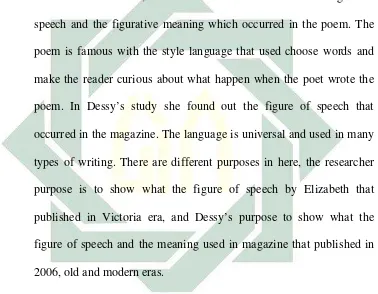



Figure Of Speech In The Elizabeth Barrett Browning S Poems




How Do I Love Thee Sonnet 43 By Elizabeth Barrett Browning Poems Poets Org




How Do I Love Thee By Elizabeth Barrett Browning Sonnet 43 Analysis Youtube
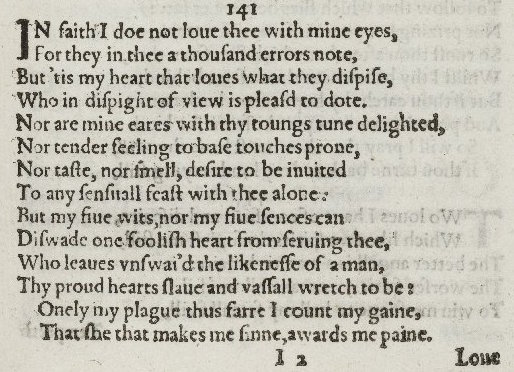



Sonnet 141 Wikipedia
(64).jpg)



Sonnet 43 By Elizabeth Barrett Browning Quiz Proprofs Quiz
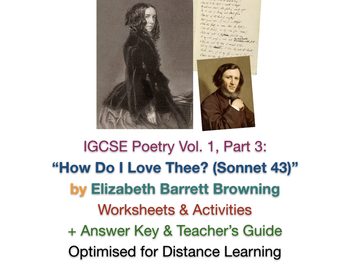



How Do I Love Thee Worksheets Teaching Resources Tpt
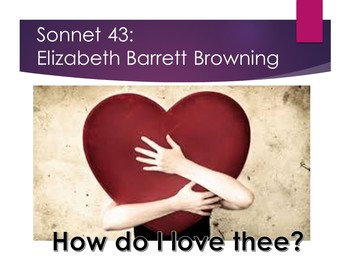



Sonnet 43 Worksheets Teaching Resources Teachers Pay Teachers




Sonnet 43 By Lauren A




Sonnet 43 How Do I Love Thee By Elizabeth Barrette Browning



Elizabeth Barrett Browning S Sonnet 43 Analysis



0 件のコメント:
コメントを投稿